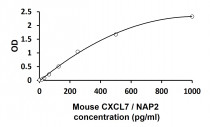ARG81724
Mouse CXCL7 / NAP2 ELISA Kit
Mouse CXCL7 / NAP2 ELISA Kit for ELISA and Mouse
Component
| Cat No | Component Name | Package | Temp |
|---|---|---|---|
| ARG81724-001 | Antibody-coated microplate | 8 X 12 strips | 4°C. Unused strips should be sealed tightly in the air-tight pouch. |
| ARG81724-002 | Standard | 2 X 10 ng/vial | 4°C |
| ARG81724-003 | Standard/Sample diluent | 30 ml (Ready to use) | 4°C |
| ARG81724-004 | Antibody conjugate concentrate (100X) | 1 vial (100 µl) | 4°C |
| ARG81724-005 | Antibody diluent buffer | 12 ml (Ready to use) | 4°C |
| ARG81724-006 | HRP-Streptavidin concentrate (100X) | 1 vial (100 µl) | 4°C |
| ARG81724-007 | HRP-Streptavidin diluent buffer | 12 ml (Ready to use) | 4°C |
| ARG81724-008 | 25X Wash buffer | 20 ml | 4°C |
| ARG81724-009 | TMB substrate | 10 ml (Ready to use) | 4°C (Protect from light) |
| ARG81724-010 | STOP solution | 10 ml (Ready to use) | 4°C |
| ARG81724-011 | Plate sealer | 4 strips | Room temperature |
Overview
| Product Description | ARG81724 Mouse CXCL7 / NAP2 ELISA Kit is an Enzyme Immunoassay kit for the quantification of Mouse CXCL7 / NAP2 in serum, plasma (heparin, EDTA) and cell culture supernatants. |
|---|---|
| Tested Reactivity | Ms |
| Tested Application | ELISA |
| Specificity | There is no detectable cross-reactivity with other relevant proteins. |
| Target Name | CXCL7 / NAP2 |
| Conjugation | HRP |
| Conjugation Note | Substrate: TMB and read at 450 nm. |
| Sensitivity | 7.8 pg/ml |
| Sample Type | Serum, plasma (heparin, EDTA) and cell culture supernatants. |
| Standard Range | 15.6 - 1000 pg/ml |
| Sample Volume | 100 µl |
| Precision | Intra-Assay CV: 5.4%; Inter-Assay CV: 5.9% |
| Alternate Names | CTAP3; Platelet basic protein; SCYB7; Macrophage-derived growth factor; THBGB; CTAPIII; C-X-C motif chemokine 7; Beta-TG; NAP-2; Small-inducible cytokine B7; TGB; THBGB1; CTAP-III; PBP; MDGF; TC2; Low-affinity platelet factor IV; Leukocyte-derived growth factor; TC1; 74; 73; 1-66; B-TG1; 1-63; CXCL7; TGB1; 1-81; LDGF; LA-PF4 |
Application Instructions
| Assay Time | ~ 5 hours |
|---|
Properties
| Form | 96 well |
|---|---|
| Storage Instruction | Store the kit at 2-8°C. Keep microplate wells sealed in a dry bag with desiccants. Do not expose test reagents to heat, sun or strong light during storage and usage. Please refer to the product user manual for detail temperatures of the components. |
| Note | For laboratory research only, not for drug, diagnostic or other use. |
Bioinformation
| Gene Symbol | PPBP |
|---|---|
| Gene Full Name | pro-platelet basic protein (chemokine (C-X-C motif) ligand 7) |
| Background | The protein encoded by this gene is a platelet-derived growth factor that belongs to the CXC chemokine family. This growth factor is a potent chemoattractant and activator of neutrophils. It has been shown to stimulate various cellular processes including DNA synthesis, mitosis, glycolysis, intracellular cAMP accumulation, prostaglandin E2 secretion, and synthesis of hyaluronic acid and sulfated glycosaminoglycan. It also stimulates the formation and secretion of plasminogen activator by synovial cells. The protein also is an antimicrobial protein with bactericidal and antifungal activity. [provided by RefSeq, Nov 2014] |
| Function | LA-PF4 stimulates DNA synthesis, mitosis, glycolysis, intracellular cAMP accumulation, prostaglandin E2 secretion, and synthesis of hyaluronic acid and sulfated glycosaminoglycan. It also stimulates the formation and secretion of plasminogen activator by human synovial cells. NAP-2 is a ligand for CXCR1 and CXCR2, and NAP-2, NAP-2(73), NAP-2(74), NAP-2(1-66), and most potent NAP-2(1-63) are chemoattractants and activators for neutrophils. TC-1 and TC-2 are antibacterial proteins, in vitro released from activated platelet alpha-granules. CTAP-III(1-81) is more potent than CTAP-III desensitize chemokine-induced neutrophil activation. [UniProt] |
| Highlight | Related products: CXCL antibodies; CXCL ELISA Kits; CXCL Duos / Panels; CXCL recombinant proteins; New ELISA data calculation tool: Simplify the ELISA analysis by GainData |
| PTM | Proteolytic removal of residues 1-9 produces the active peptide connective tissue-activating peptide III (CTAP-III) (low-affinity platelet factor IV (LA-PF4)). Proteolytic removal of residues 1-13 produces the active peptide beta-thromboglobulin, which is released from platelets along with platelet factor 4 and platelet-derived growth factor. NAP-2(1-66) is produced by proteolytical processing, probably after secretion by leukocytes other than neutrophils. NAP-2(73) and NAP-2(74) seem not be produced by proteolytical processing of secreted precursors but are released in an active form from platelets. [UniProt] |
Images (1) Click the Picture to Zoom In
| Title | Download Link |
|---|---|
| ARG81724 Mouse CXCL7 / NAP2 ELISA Kit User's manual |
 Download Download
|






